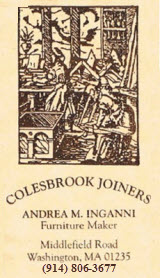Shaker Tall Clock |

|
||
|
As I progress through the build of a project I take pictures and display them so that you can see what goes into a piece. These are views you can't get, and hence can't appreciate, when you view the finished piece. It is these details that separate custom built furniture from commercial furniture.
In the
picture on the right you see a nearly assembled dust
panel which sits at the bottom of the clock base. As you
might guess it functions to keep dust out of the clock
movement. This panel is made using frame and panel
construction much like frame and panel doors. Notice the
use of traditional mortise and tenon joinery. The
assembled base,
minus quarter round trim, is shown in the picture at
left. Click on the picture to enlarge it and you will
see that the grain is matched all around the base. This
is achieved by starting with one long glue up and then
cutting and "folding" the front and sides. Compare the
shape of the base and its feet to the 3D rendering
above. As I add photos in this "Progress Update" section
continue to follow along comparing the sub-assemblies to
the 3D rendering and you will get a feel for how
valuable this tool is. Inside the base is pretty busy. The picture at right shows how the waist (the middle section) is connected to the base with blocking. The blocking is glued to the base sides. This is permissible because the grain is flowing in the same direction for both pieces. However the waist sides are connected to the blocking using screws with oversized holes in the sides to allow for cross grain expansion. A similar techniques is used in the corners of the base face and sides. Notice the small corner blocks with two screws each. This allows the face and sides to expand without breaking the corner joint. Lastly you can see the dovetail joinery on the feet corners. These are half-blind hand cut dovetails. Half-blind means that the joint can be seen from only one side. In this case the back, leaving the feet sides clean. The clock
waist is the simplest sub-assembly of the three Getting
the dimensions and placement of the sides correct,
relative to
The
hood, shown right,
is the most difficult of the three assemblies. It
consists of an arched pediment with half-blind
dovetails, a top and sides connected by through
dovetails the sides providing small arched windows into
the clock mechanism, turned columns, an arched door and
dial frame, door and base. I start by constructing the
pediment. The pediment sides need to
be milled
with the tails of the dovetail joint. The tails are
carefully marked up
with a pencil. I always mark the waste area with Xs to
be sure I cut away the correct material. Once
Next I
glue up the pediment
and let it dry over night. The clamps are used primarily
to keep the sides square to the front while the glue
sets.
When the
pediment glue up is dry the backing board can be
attached to increase the thickness of the front and then
the arch is milled. You can see this in the
picture at left.
I have wet the surfaces with mineral spirits so the
dovetails show
Next I mill the windows in the sides of the hood. I use a patterning router bit to form the rectangular portion and the oscillating sander to form the small arches. The decorative roundover is milled with the router bit, but this operation leaves round corners, shown at right. The round corners must be cleaned up to form roundovers that intersect in a square corner. A sharp chisel and careful paring are the stars of this show. At left you can see the
assembled hood consisting of the sides, pediment,
bottom, dial frame (just inside the door) and door. The
dial frame dresses up the dial face when the door is
open. A special hinge called a pivot hinge is required
to allow the door to clear the overhanging arch when it
is opened. At right is the hood, in the state of completion shown at left, mounted on the base and waist assembly. The clock works are placed inside so that I can inspect the alignment of the face with the door openings and make any adjustments that may be necessary at this time. The hood
has traditionally been designed to be removed for
cleaning, adjustment or repair of the clock works. At
this point it is supported by temporary blocking nailed
to the waist sides. However, the waist trim will support
the hood in the completed clock. The picture at left shows the
clock completed except for the pillars and the back.
Note how the trim now supports the hood. Next I will turn the hood pillars on the lathe, and then construct the clock back. The back is one long piece connecting all three assemblies. The back will go on after the movement is installed in the hood. The finished clock is shown at right. Front and side views of the hood show the detail of the arched door, trim and turned pillars. Compare these views with the 3D rendered drawings above.
|
My SketchUp Book
My SketchUp Courses
NESAW

Berkshire Woodworkers

|

























